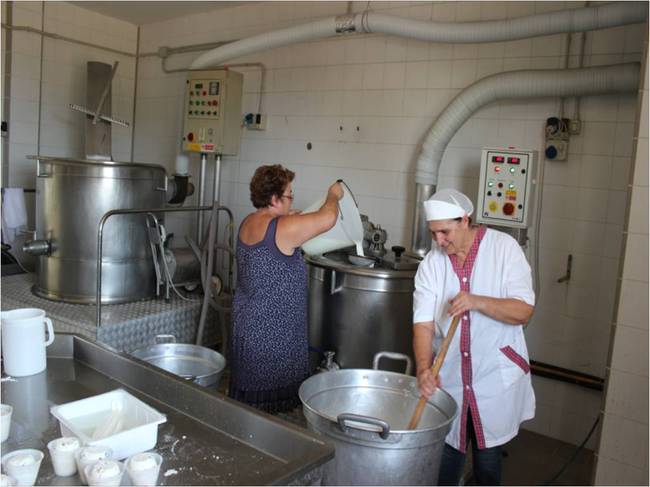 Maria at Masseria la Greca outside Lecce in Salento, Italy
Maria at Masseria la Greca outside Lecce in Salento, Italy
Since the end of last summer we’ve been acquiring the bits and pieces to put together the creamery. The primary components we’re interested in are the milking system (pipeline or bucket, we don’t know yet), the bulk tank and the cheese vat. The milking system is exactly what it sounds like. It includes the piping and the vacuum system required to milk the animals. In a bucket system you pump the milk directly into buckets and then dump it into the bulk tank. In a pipeline system you pump the milk through a pipeline that flows directly into the bulk tank. There are other variations as well, but those are the basic methods. The bulk tank is where the milk goes for cooling after milking. It cools the milk to approx 40 degrees within an hour or two. Once the milk in the tank is cool and you have enough to make cheese you open up a pipeline and the milk flows to your vat. From there you begin the cheesemaking process. Aside from the construction of the building, these three pieces of equipment are typically the largest capital expenses.
Last summer we got very lucky and found a highly affordable vat being refurbished after use at a University on the west coast. The process took six months of intensive hunting and networking. Not as simple as an eBay search. Then our inspector spoke on the phone with the fab guy, we sent the inspectors detailed photos and spec sheets and eventually we got the green light. Once we get our creamery construction underway we’ll have it shipped out and it will need to be inspected and approved all over again.
Over that time we’ve also been looking for an affordable bulk tank. Part of our struggle is that we need a tank in the ~100 gallon range since that’s how big our vat is and that coincides with the range of milk we’ll be storing. Most tanks require at least 10% of their total volume to function properly, so you can’t just get a huge tank and make it work. If you get a 100 gallon tank you need 10 gallons at the first milking for the agitator to touch the milk. The agitator needs to touch the milk to keep it moving and keep the milk from freezing. If you don’t have enough milk you could theoretically go out and stir the milk yourself every few hours, but that sounds crazy. I don’t even know if our inspector would be OK with that.
Anyway, 100 gallons is quite small by today’s standards. Really too small for tank manufacturers to deal with anymore. Small dairies don’t exist in large enough numbers to warrant the manufacture of such equipment. The smaller tank sizes are quite prevalent in Europe, where small dairies exist by the thousands, but not in the USA. Small equipment just isn’t easy to come by. In addition, to rub salt in the wound, large equipment is not only easier to find, it’s often cheaper. 100 gallon bulk tanks can be in the $10,000 to $20,000 range, new or used, whereas much larger new bulk tanks can be in the single thousands and used ones can be found in the hundreds. Go figure.
One answer is to find a good European tank and have it shipped over here. With the cost of freight and the unfavorable exchange rate, however, that is often not a very cheap solution. For the most part, there are distributors in the US that already do that and the cost is still $10,000+. On top of that, most European manufacturers don’t make equipment that meets the strict U.S. standards. For instance, one day last week I’m perusing our usual sources and I notice a brand new European tank that’s a good size for us and being offered at a great price (almost half of what we expected to pay). Turns out the tank has a few intricacies that don’t exactly meet 3A sanitary standards. 3A sanitary standards are a set of third-party guidelines that equipment is required to meet for use in a commercial dairy in Tennessee. In this instance there are literally two screws and a valve that are too long. The distributor doesn’t want to risk us re-fabricating the noncompliant parts only to have the inspector potentially reject it, so that piece of equipment is, for all intents and purposes, off limits to us. We’ve run into similar roadblocks with other tanks before. So we continue our search. Right now we have one very good prospect that we’re waiting for pictures and more details on, but other than that we’re still on the hunt.

